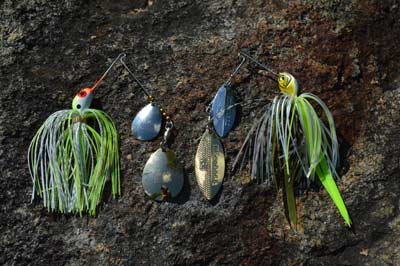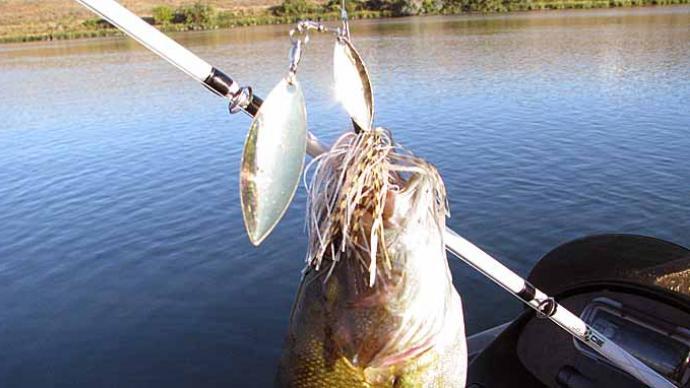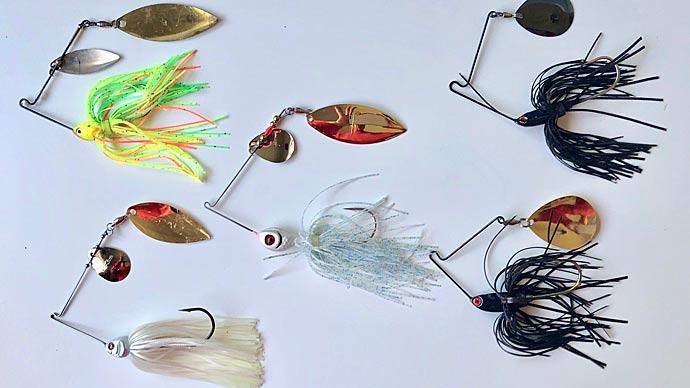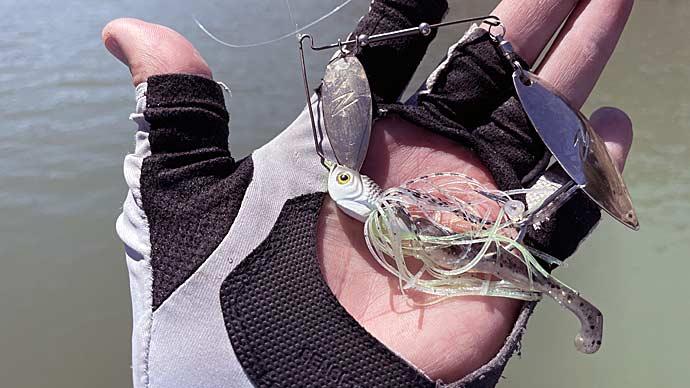
Smallmouth love spinnerbaits. While that may be considered common knowledge among bass anglers, it needs to be said, an excellent refresher in today’s bass fishing world, where finesse techniques, such as drop shots and Ned rigs, dominate when it’s time to chase bronzebacks.
Smallmouth show no fear when it's time to track down and eat a meal, so it's easy to see why they strike spinnerbaits. They are loud and splashy, attracting smallmouth from great distances and through tough conditions, whether the low light of a cloudy or windy day or stained water of a river. Anglers like them because they are relatively easy to use — cast and wind, for the most part — and the single hooks hold fast and true, even though a smallmouth's trademark aerial acrobatics and drag-ripping lunges.
Like most of today’s lures, spinnerbaits have become specialized. While you may have a favorite that catches smallmouth most days, matching weight and blade combinations to the fishing situation that you’re currently facing will mean more and bigger smallmouth in your boat. Packing these three combinations in your tackle box will prepare you for the most common places where smallmouth swim.
Small Double Blades
Smallmouths and rivers go together like peanut butter and jelly. And while they hang close to the current in summer and most of the fall, winter and spring find them huddled in slack water. It could be on the inside of a large bend, a secondary channel, or backwater. They’re all perfect places to fish a small double-blade spinnerbait.
A typical small spinnerbait weighs 3/16 or ¼ ounce. They're made lighter, but those are difficult to cast accurately. In addition to a silicone skirt — lighter colors in clear water and darker ones in stained or muddy water — it sports a combination of small blades, such as a No. 3 Colorado and No. 4 willow, No. 3 and No. 4 Colorados, or a No. 3 Colorado and No. 4 Indiana. Gold blades are best all around, but it doesn’t hurt to experiment with nickel ones on sunny days and in clear water.
This combination of weight and blades accomplishes three things. First, they better match the small prey that makes up most of a river smallmouth's diet. The small blades provide little lift, allowing you to present your spinnerbait down in the water column, paralleling a laydown or riprap, casting to a channel-swing bank, or targeting an isolated boulder. And its lightweight forces a slow retrieve, perfect for smallmouth in cold or warming water.
Short baitcasting rods — 6 to 7 feet — are best here, especially when using underhand roll casts to put your spinnerbait deep into a laydown. Stick with rods that have a fast action, medium power, and two-handed handle; use your lower hand to guide the tip toward your target, improving accuracy. Match it to a reel with a gear ratio of about 6:1. That will help keep your retrieves slow.
Finally, spool it with 12- or 15-pound test monofilament or fluorocarbon line. They have a larger diameter than braided line, making them less likely to wedge into bark crevices or wrap around small branches on laydowns.
Single Spin
If I close my eyes, I can still remember the spots and feel the bites from a day long ago on New York’s Mohawk River. The fishing was simple — allow your spinnerbait to fall, following the contour of steep banks right into the jaws of smallmouth waiting behind small current breaks. And tying on a single-spin spinnerbait made it all possible.

Spinnerbaits that feature a single blade is a frequently dismissed option. You must dig deep into a website or check the lowest shelves at the tackle shop to find them. But more anglers need to remember them when they are on the water, especially when the temperature is near its coldest or hottest points of the year.
These spinnerbaits are all about the fall. Ones with short arms — the distance between the line tie and blade — helicopter better, making them perfect for more vertical presentations. They’re a favorite of anglers who prefer fishing after dark. On the other hand, long arms allow the blade to create more vibration and better protect the hook from snagging cover. They're most at home along sloping bottoms when you need a spinnerbait that runs deep.
Single-spin spinnerbaits should weigh no less than 3/8 ounce, and you’ll want heavier ones as depth increases. Colorado blades, especially those with a deep cup or hammered finish, make the most vibration, which is essential when they’re working alone. Choose blade color based on water color and light levels. Dark days or stained and muddy water do best with gold or copper blades. When skies and water clear, switch to silver blades that are smooth.
Choose a 7-foot baitcasting rod for single-spin spinnerbaits. Fill its reel, whose gear ratio should be about 7:1, with 15- or 20-pound test braided line. Its sensitivity will help you feel strikes that occur as your spinnerbait is falling on line slack.
Big Double Willow
Bass tournament legends Jimmy Houston and Rick Clunn have won tournaments held on the St. Lawrence River and eastern Lake Ontario. And while their winning catches are anemic compared to the goby-fueled smallmouth that swim there now, they both leaned on spinnerbaits to get it done.
A consistent producer still today, double-willow spinnerbaits ruled Northeast smallmouth fishing in the 1980s and 1990s. They were a top choice on Lake Ontario, Lake Champlain, and New Hampshire's Lake Winnipesauke. What made them productive was their color — chartreuse or white skirts and painted blades were vital — and their speed. You couldn't fish them too fast or shallow from early summer through mid-fall.
Generating enough speed to trip reaction strikes starts with the correct blades. A No. 4 leading blade and No. 4.5 trailing blade is a good starting point. While some anglers prefer both blades to be silver and others want gold ones, having one of each in either order works almost everywhere. Painted blades can be a good choice if wind blows or storm clouds hang low in the sky.
You’ll want a heavy head to balance the blades’ pull and keep your lure tracking true during high-speed retrieves. A ½-ounce model is a good starting point. But don’t hesitate to step up to a ¾-ounce one. The latter is a good choice if the wind is stiff or you want your spinnerbait to run slightly deeper to tick cover, such as aquatic vegetation.
Match these heavy spinnerbaits to solid gear. A casting rod that measures at least 7 feet long facilitates long casts. Its heavy power brings enough backbone to launch these spinnerbaits, set the hook at any distance, and land smallmouth supercharged by relatively warm water. And its fast action supports casting distance and cushions violent strikes.
Match your rod to a reel that sports a gear ratio of about 7:1. It requires less effort to generate speedy retrieves and still provides power. Even with willow blades, these spinnerbaits pull hard. So, fill its spool with at least 15-pound test fluorocarbon or monofilament line. Its larger diameter will help your spinnerbait run shallower and provide some stretch, ensuring your lure’s hooks hold rather than tear.
Common Traits
While each of these spinnerbaits fills a unique niche, they have things in common. These traits are essential, helping your spinnerbait run true and catch more. Here’s what you want.
Choose spinnerbaits built with a frame made from .035-diameter or thinner wire. They have the most action, though they lack strength, leading to short lifespans. But all the big smallmouth you catch on them should lessen the blow when you're at your favorite tackle shop, ponying up the cash to purchase new ones.

Look for a hook that has a wide gap. It isn't the extra-wide gap that some worm hooks sport. Instead, the point and shank should be parallel, connected by a round bend. You want the distance between the point and the shank to be as wide as possible. That leads to better hookups.
A high-quality swivel, used to attach the trailing or single blade, ensures your blade turns even at the slowest speed. They also last longer. It’s not much fun to pull your favorite spinnerbait out of your tackle box only to find rust seized its swivel during storage. And use ones that sport strong split rings on both ends. While the idea of having a snap on one end may be inviting for quickly blade changes, you’re unlikely to ever change one. It also can open, causing you to sling a blade. And if you did, it’s no more difficult to open the split ring.
A trailer hook is an integral part of any spinnerbait. Bass often swipe at them, reacting to the action created at the blade or blades and in the skirt. And those swipes often end up missing your spinnerbait's single hook. So, always add a trailer hook. Its size can be slightly smaller than the main hook, but it needs to move freely to reduce snags. Discard the surgical tubing that’s slipped over the eye of most trailer hooks. Instead, use pliers to squeeze the hook’s eye, reducing its diameter once it’s on the main hook. Or you can slide a stop on the main hook after adding the trailer hook. You can use that piece of surgical tubing in a jam, and some anglers use a hole punch to create small plastic discs from a coffee can lid.
Before you add a trailer hook, consider adding a trailer. Whether something designed explicitly for spinnerbaits, a piece of plastic worm, or soft-plastic grub, add action and bulk. And the last one will help slow your retrieve and make it easier to keep your lure higher in the water column.




